I have been, or can be if you click on a link and make a purchase, compensated via a cash payment, gift, or something else of value for writing this post. As an Amazon Associate, I earn from qualifying purchases. Please read my full Affiliate Disclosure for more information.
Ever feel like your living room is a little too cozy for comfort? Small living rooms are increasingly popular because they challenge us to get creative with space, making every inch count without sacrificing style or comfort. Clever design ideas can turn these compact areas into functional, welcoming hubs where you want to relax and entertain.
In this article, you’ll find a variety of small living room ideas that blend practicality with aesthetic charm. From smart furniture choices to clever storage solutions, these tips will inspire you to maximize your space and create a room that feels bigger, brighter, and more inviting. Get ready to transform your small space into a stylish sanctuary!
1. Multi-Functional Furniture with Hidden Storage
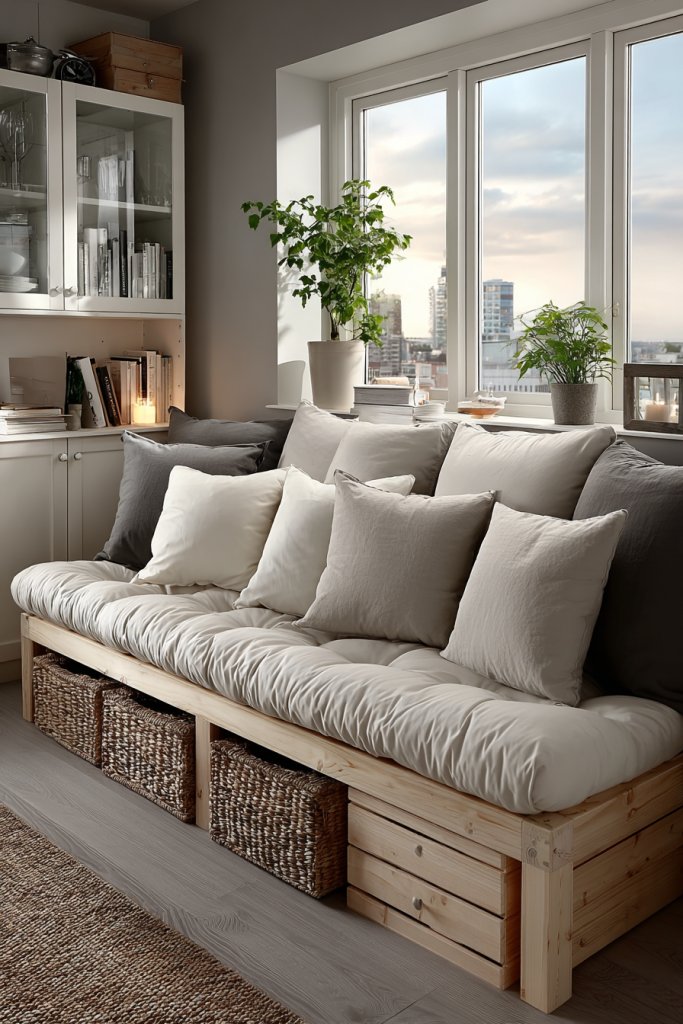
Living in a small space often feels like fighting a losing battle against clutter. Every surface seems to collect odds and ends, making the room look chaotic and cramped. You want a solution that keeps things tidy without sacrificing style or comfort. Multi-functional furniture with hidden storage promises to turn that chaos into calm, giving you more space to breathe.
Imagine a sleek sofa with built-in compartments beneath the cushions, perfect for stashing away throw pillows or magazines. Or a coffee table with a lift-top that reveals a secret storage space for board games or blankets. The textures range from plush fabrics to smooth wood finishes, all designed to blend seamlessly into your decor. These pieces look like regular furniture but serve double duty, giving your room a clean, uncluttered vibe.
You can go minimalist with monochrome finishes or add pops of color with vibrant upholstery. For a cozy winter look, pair a storage ottoman with a soft, textured throw. In summer, opt for lightweight, airy materials to keep the space feeling fresh. Smaller apartments might favor wall-mounted fold-away beds that combine sleeping and seating, while larger rooms can handle larger sectional sofas with integrated storage. The key is choosing versatile pieces that match your style and space.
Start by measuring your available space and deciding what items you need to hide away. Look for furniture with built-in compartments, lift-up lids, or hollow bases. Prioritize quality construction—cheap pieces will fall apart fast, defeating the purpose. Assemble according to instructions, ensuring hinges and locks work smoothly. Consider adding organizers or dividers inside storage units to keep everything orderly. For DIY enthusiasts, repurposing old furniture with added compartments can be a fun project, but professionally made options often look more polished.
Customize your multi-functional pieces with removable covers, slipcovers, or decorative throws that reflect your personality. Add labels or small baskets inside storage units for easier access. Paint or stain wooden furniture to match your existing color scheme. Incorporate personal touches like engraved initials or unique hardware to elevate the look. These small details make your furniture not just functional but truly personal.
This approach turns your living space into a showcase of smart design. With clever storage solutions, you’ll find yourself more organized and less stressed. Plus, it’s a fun way to experiment with your decorating style without breaking the bank. Ready to transform your cluttered chaos into a sleek, functional oasis?
2. Vertical Wall Shelving for Display and Organization
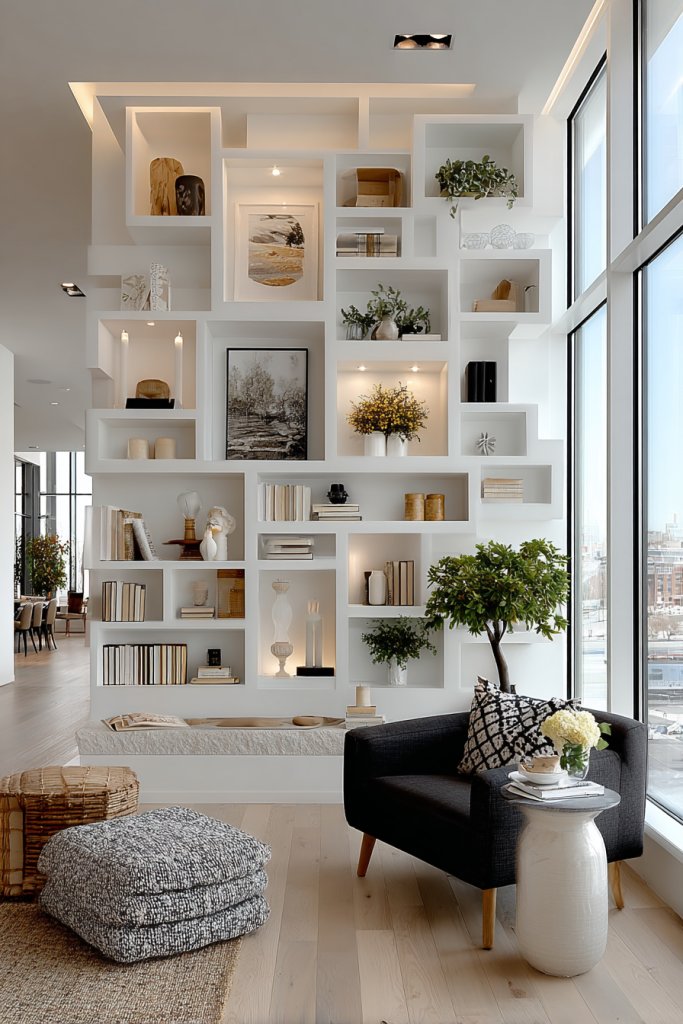
Vertical wall shelving offers a smart way to maximize your small living room without cluttering your space. Instead of bulky cabinets or furniture that takes up valuable floor area, sleek open shelves run vertically along the walls, giving you a dedicated spot for everything from books to decorative objects. This approach keeps your main floor clear, making the room feel more open and less cramped. Plus, it adds a touch of modernity—who doesn’t love a clean, organized look that feels effortlessly chic? The key is choosing the right size and style so it complements your overall vibe without overwhelming the space.
Visual storytelling here is all about creating a sense of height and openness. Think of shelves made from lightweight materials like thin metal or floating wood planks, which seem to “disappear” into the wall. You can arrange items like neatly stacked storage boxes, decorative ceramics, or even sculptural pieces that add interest without adding bulk. Soft lighting integrated into the shelving can highlight your favorite finds and bring warmth to the room without relying on traditional lamps or pendants—FYI, those are not necessary for this concept. The textures and finishes play a role too; matte or natural wood finishes add warmth, while sleek metals lend a contemporary edge.
Adapting this idea to fit your personal style and space constraints is pretty straightforward. For a minimalist look, opt for simple, monochromatic shelves with a few carefully selected storage baskets or decorative items. If you want a more eclectic vibe, mix and match different shelf sizes and finishes, adding in small sculptural elements or textured storage bins. During different seasons, you can switch out display items—think cozy textiles or seasonal ornaments—without changing the entire setup. This flexibility means your vertical storage can evolve with your taste and needs without cluttering your room.
Implementation-wise, installing wall shelves is usually a breeze, especially with some basic tools and a stud finder. First, decide where you want the shelves—above a sofa or along an empty wall—then mark the spots carefully. Use sturdy anchors and brackets to ensure safety—no one wants a shelf crashing down with their favorite book collection. When arranging items, keep heavier objects at the bottom and lighter ones higher up, which helps maintain stability and visual balance. Remember, this isn’t just about function but also about creating a visually pleasing arrangement that feels curated rather than cluttered.
To make your vertical shelves truly work for you, think beyond just storage. Incorporate sculptural elements, textured ceramics, or decorative boxes to add visual interest. You can also use the shelves to display personal mementos, without turning your living room into a cluttered shrine—just a few thoughtfully chosen pieces. Keep the overall look streamlined by sticking to a cohesive color palette or material finish, which makes the space feel harmonious. The beauty of this setup is that it’s both practical and stylish, offering a place for everything and hiding what you don’t want to see—no overstuffed cabinets needed.
Vertical wall shelving is one of those small tweaks that can totally change your space. It frees up precious floor real estate, makes your living room appear taller and more spacious, and adds a modern, organized vibe that’s perfect for any style. Plus, it’s super customizable: you can add or remove shelves as needed, switch out display items, or even paint the shelves to match your wall color. Once you get the hang of it, you’ll wonder why you didn’t do this sooner. It’s a simple, effective way to keep your small living room looking fresh, functional, and fabulous.
3. Compact Corner Sofa for Cozy Seating
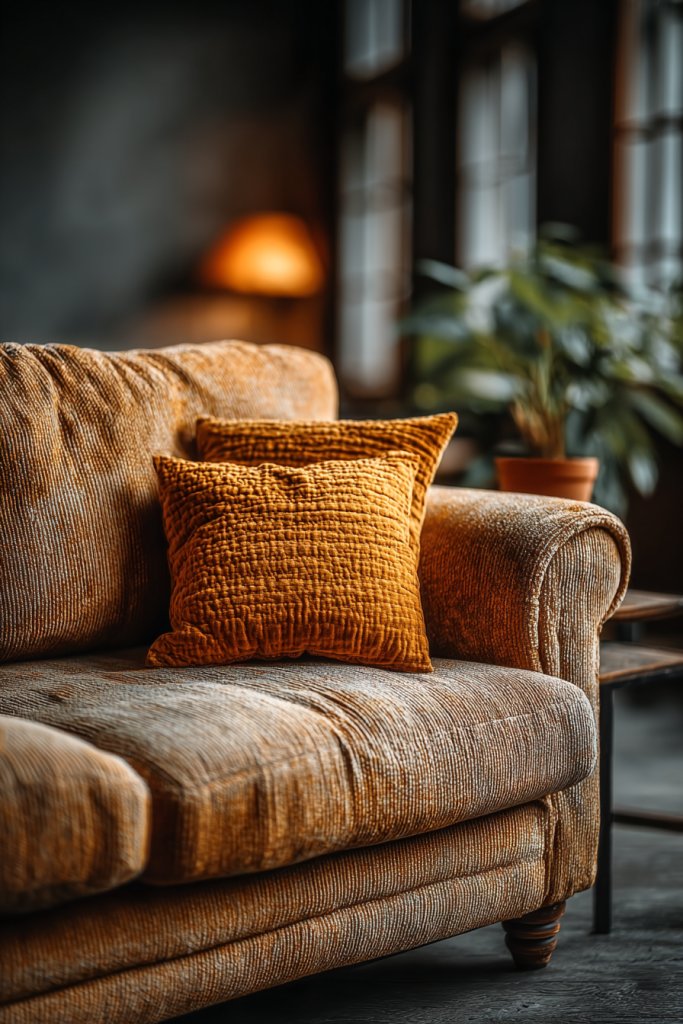
A small living room can feel like trying to fit a square peg into a round hole—seating is often the first casualty. You want a comfy spot to lounge without sacrificing precious floor space. The solution? A compact corner sofa that maximizes seating while fitting snugly into a corner. It’s like having a custom fit that makes your room feel larger and more inviting.
Picture a sleek L-shaped sofa tucked into a corner, upholstered in a soft neutral fabric that complements your walls. The design features slim arms and a low profile, giving an airy feel. Toss in a few decorative cushions in contrasting colors or textures for a pop of personality. The sofa’s placement creates a natural boundary for the space, making everything feel more cohesive and intentional. With a small coffee table nearby, you have a perfect spot for coffee, snacks, or a good book.
Choose a modular corner sofa that can be reconfigured based on your needs, whether for entertaining or relaxing alone. For a minimalist look, pick one with clean lines and a single solid color. If your style is more eclectic, mix and match cushions and throws. Seasonal changes can be reflected with cozy plaids in winter or light, breathable fabrics in summer. For tiny rooms, opt for a two-seater with a chaise for extra lounging space without overwhelming the room.
Measure your corner space carefully, considering doorways and walkways. Look for sofas with slim profiles and adjustable configurations. Assembly usually involves connecting sections and attaching legs—most are straightforward enough to do yourself. Place the sofa in the corner, ensuring it doesn’t block windows or doorways. Add a small side table or a pouf nearby for extra functionality. Regularly vacuum and rotate cushions to maintain its fresh look.
Add a cozy throw blanket or a collection of decorative cushions that match your decor palette. Use a textured rug underneath to anchor the seating area. Incorporate a statement wall behind the sofa with paint, wallpaper, or wall decals for visual interest. Personal touches like a small sculpture or a stack of favorite books nearby can make the space truly yours.
A corner sofa makes your small living room feel more spacious and inviting. It’s a smart way to create a comfy retreat without cluttering the center of the room. With the right choice, you can entertain guests comfortably and still enjoy a cozy night in. Who says small can’t be stylish?
4. Light and Bright Color Palette to Enhance Perceived Space

Dark walls and heavy furniture can make a small living room feel even tinier. You want to open up the space visually, making it feel airy and inviting. The easiest trick? Use a light and bright color palette that reflects natural light and creates a sense of openness. Bright colors can instantly transform your cramped quarters into a cheerful retreat.
Imagine walls painted in soft creams, pale blues, or gentle pastels that bounce light around the room. The floor is covered with a neutral-toned rug that complements the walls without overwhelming. Light-colored furniture, perhaps in whites or soft greys, blends seamlessly with the walls, maintaining a cohesive look. Natural light streams through windows, enhanced by sheer, airy curtains. The overall effect is a space that feels larger, cleaner, and more welcoming.
You can add warmth with accent cushions or throws in brighter hues or subtle patterns. Seasonal updates include swapping out darker accessories for lighter, more vibrant options. If your room gets limited sunlight, consider adding mirrors to reflect what little light there is. For a cozy winter look, layer with textured textiles in neutral shades; in summer, keep it breezy and minimalist. The key is balancing brightness with comfort.
Start by choosing a light color palette for walls—always test samples first. Select furniture in light tones that won’t absorb too much light or make the space feel heavy. Use reflective surfaces such as glossy tables or metallic accents to amplify light. Keep window treatments minimal and opt for sheer or light-filtering fabrics. Declutter surfaces to maximize the effect of the light and keep the room feeling open. Small changes like painting trim or ceilings in bright shades can add depth without darkening the space.
Introduce textured textiles like linen cushions, woven rugs, or soft throws to add subtle depth. Personalize with artwork or decorative objects in light colors to maintain the airy feel. Consider repainting or touch-ups to keep the walls looking fresh and bright. Using light-colored storage baskets or containers helps keep clutter out of sight while maintaining the overall brightness.
A bright, light palette can make your small living room feel expansive and cheerful. It creates an environment that lifts your mood and encourages socializing. Plus, it’s an easy way to refresh your space without major renovations. Ready to brighten up your home?
5. Space-Saving Fold-Down Tables for Versatile Use
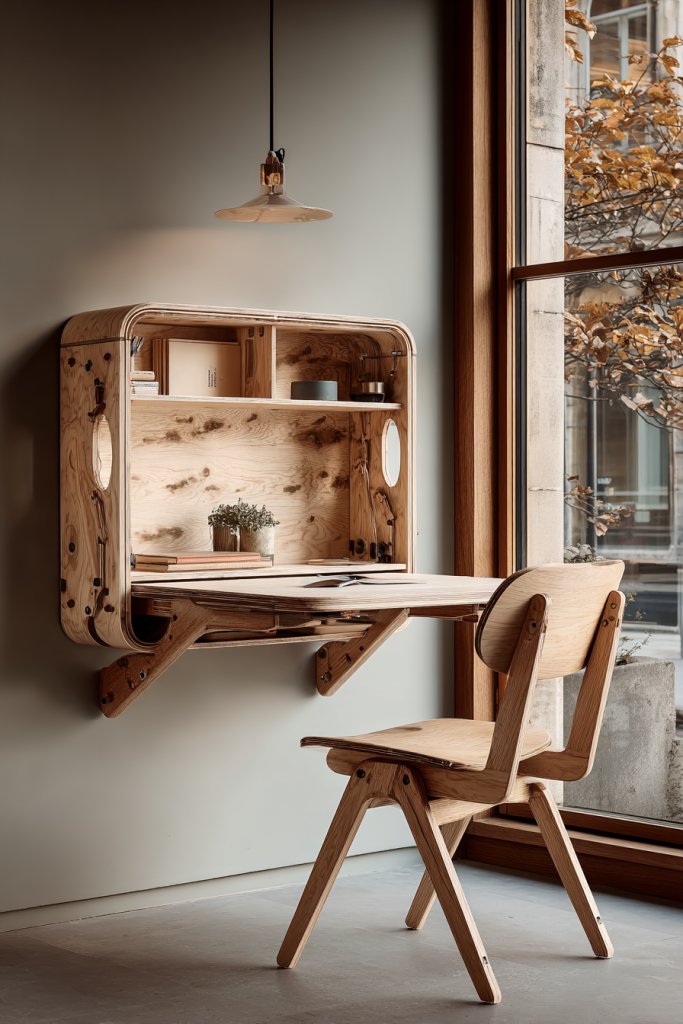
Living in a small space means every square inch counts, especially when you need a table for dining, work, or hobbies. Fixed tables can take up valuable floor space, making the room feel cluttered and cramped. The perfect fix? Fold-down tables mounted on the wall that can be tucked away when not in use. They offer versatility without sacrificing style or functionality.
Visualize a sleek, minimalist table folded flat against the wall, with a simple latch mechanism. When needed, you release the latch, and the table folds down smoothly, revealing a sturdy surface in a light wood or colored finish. When not in use, it disappears, leaving the room open and airy. The surrounding decor stays clean and uncluttered, with chairs stacked or stored away. This setup feels almost like magic, transforming a tiny corner into a multifunctional zone.
Choose different sizes and shapes depending on your needs—round for casual meals or rectangular for work. For a modern aesthetic, opt for sleek metal frames and smooth laminate surfaces. In a vintage-inspired room, go for distressed wood finishes and decorative brackets. Seasonal variations may include adding a fold-up extension or a protective coating for outdoor use. The key is selecting a design that fits your lifestyle and decor.
Start by identifying a suitable wall with enough clearance for the table to fold down without obstruction. Use a level and stud finder to securely mount the brackets or hinges. Choose a durable, easy-to-clean surface material that matches your style. Ensure the latch mechanism is reliable and simple to operate. Keep fold-away chairs nearby or stackable options for easy storage. Regularly check hinges and latches for wear, and clean the surface to maintain its look.
Personalize your fold-down table with decorative edge trim or painted accents. Use cushions or padded chairs for added comfort when in use. Incorporate a small shelf or hooks nearby for storing essentials like utensils or stationery. You can also add a decorative panel or artwork above the table for visual interest when it’s folded up. These details help your space feel intentional and stylish.
Fold-down tables are a smart way to maximize your small space’s potential. They make multifunctional living effortless and stylish. Once installed, you’ll wonder how you ever managed without this clever solution. Ready to reclaim your space?
6. Clear Glass or Lucite Furniture for Visual Openness
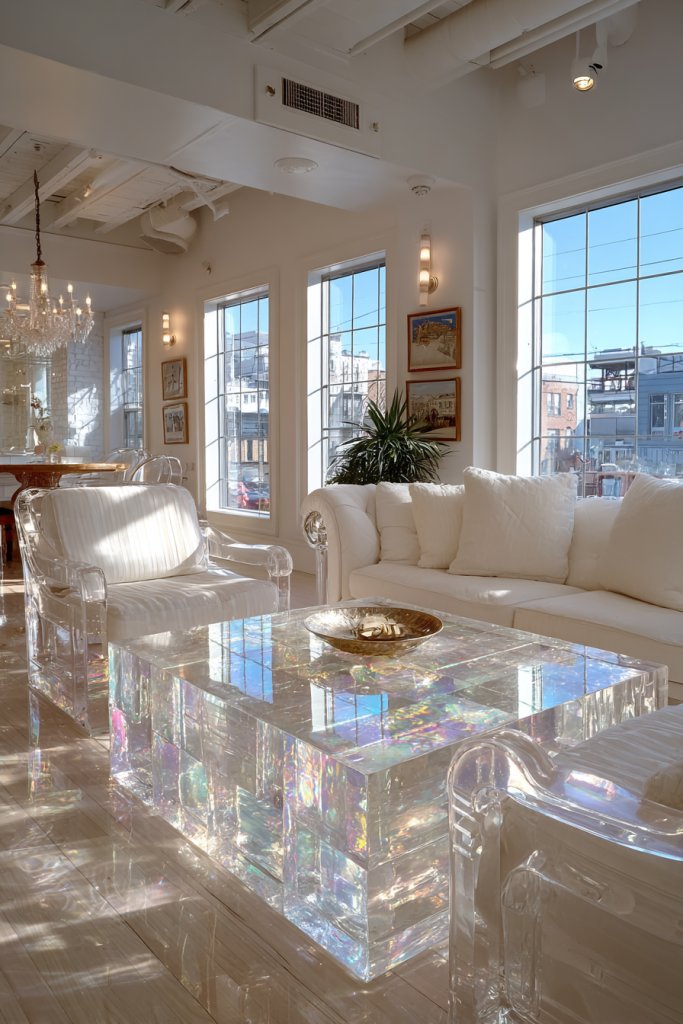
Heavy, opaque furniture can make a small room feel closed-in and claustrophobic. You want to create an airy, open environment that invites natural light and makes the space appear larger. Using transparent or semi-transparent furniture pieces can instantly boost the sense of openness. It’s like creating a visual breath of fresh air within your tiny home.
Imagine a clear acrylic coffee table with sleek, rounded edges that almost disappear into the room. Or a set of lucite side chairs that look lightweight and unobtrusive. The transparent furniture catches and reflects ambient light, brightening the space. The textures of surrounding textiles—soft throws or cushions—contrast beautifully with the sleek, modern furniture. The overall effect is a space that feels less cluttered and more expansive.
Choose furniture with minimalist designs, like clear nesting tables or floating shelves made of acrylic. For a more eclectic vibe, mix transparent pieces with colorful textiles or decorative objects. Consider adding a few matte-finish accessories or soft textiles to soften the look. For seasonal updates, swap in textured or patterned covers for nearby cushions or throws. The key is balancing transparency with tactile comfort.
Select high-quality acrylic or lucite that’s durable and resistant to scratches. Measure your space carefully to ensure the furniture fits comfortably without blocking pathways or views. Assemble according to manufacturer instructions, often involving simple screws or clips. Place the furniture in spots that maximize light reflection—near windows or under open ceilings. Regularly clean with a soft cloth to keep the surfaces pristine and streak-free. Avoid overcrowding to keep the airy feel intact.
Personalize with colorful textiles or decorative pillows to add warmth and personality. Use fabric or paper wraps on nearby objects to introduce texture and color contrast. Incorporate sculptural elements or artistic accessories that complement the transparency. Experiment with lighting—such as LED strips—to highlight the furniture’s sleek design and create ambiance. These touches make your space feel curated and unique.
Transparent furniture elevates your small living room into a modern, sophisticated haven. It makes your space feel more open and inviting, perfect for entertaining or relaxing. Once you experience the visual lightness, you’ll never want to go back to bulky furniture. Ready to make your space feel bigger and brighter?
7. Mirror Placement to Expand Visual Dimensions

Small rooms often suffer from a lack of natural light and perceived space. Mirrors are an age-old trick to visually expand a room, bouncing light and creating the illusion of depth. If your living space feels cramped or dark, strategic mirror placement can make a dramatic difference. It’s a simple, cost-effective way to elevate your decor and your mood.
Imagine a large, frameless mirror hung opposite a window, reflecting sunlight into every corner. Or a series of smaller decorative mirrors arranged in a geometric pattern on a blank wall. The reflections multiply the natural light, making the room brighter and more open. The mirror’s frame can be sleek and modern or ornate, depending on your style. The overall effect is a space that feels double its size, full of light and air.
Use full-length mirrors in bedrooms or entryways, while smaller mirrors work well in living areas or above consoles. Experiment with asymmetrical arrangements or create a gallery wall with decorative mirror shapes. Seasonal updates include adding a decorative frame or integrating mirrors into furniture like cabinet doors. For maximum effect, combine mirrors with light-colored walls and minimal clutter. Adjust placement based on the natural light flow and room layout.
Choose a sturdy wall with enough space for the mirror(s). Secure heavy mirrors with appropriate anchors, especially if placed high or in high-traffic areas. Use a level to ensure perfect alignment to avoid crooked reflections. Clean the mirror regularly and keep surrounding areas clutter-free for maximum brightness. For a cohesive look, match the mirror frame style with other decor elements. Consider adding a secondary light source nearby to enhance reflection quality.
Frame your mirrors with decorative moldings or painted borders for a custom look. Incorporate small accent lights or sconces to highlight the mirror and add ambiance. Use decorative tape or decals on the mirror’s edge for a playful touch. Personalize with family photos or artwork reflected in the mirror to add a personal touch to your decor.
Mirrors are a simple yet powerful way to transform your space. They boost brightness, add depth, and reflect your personality. With thoughtful placement, your small living room can feel much larger and more inviting. Ready to reflect your style?
8. Vertical Storage Solutions with Tall Cabinets
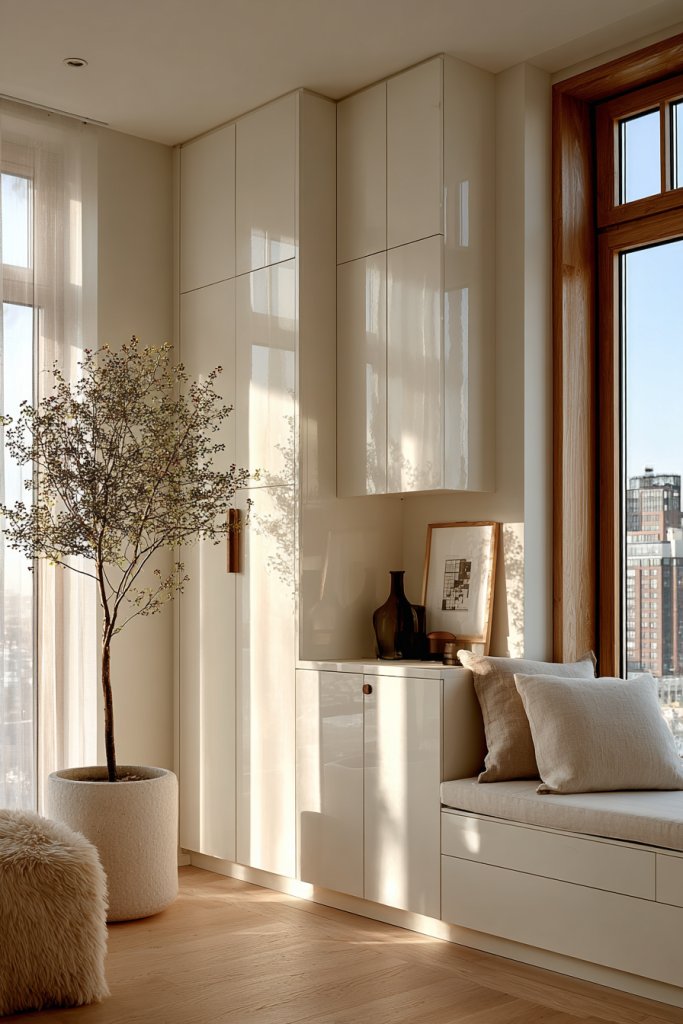
Cluttered surfaces and cramped corners make small living rooms feel even more restrictive. You need a storage solution that uses every inch of vertical space without encroaching on your living area. Tall, slim cabinets are perfect for this—they store a ton while taking up minimal footprint. Plus, they look sleek and modern, blending into your decor.
Picture a tall, dark wood cabinet reaching nearly to the ceiling, filled with neatly organized baskets, books, and decorative boxes. Its slender profile fits snugly into a narrow alcove, freeing up floor space. The cabinet’s vertical lines draw the eye upward, emphasizing height and making the ceiling appear taller. The doors hide clutter and keep your room looking tidy, while subtle hardware adds a touch of elegance.
Choose from different finishes—matte paint, gloss, or natural wood—for different interior styles. Incorporate open shelving for display, or go fully enclosed for a clean look. In small bedrooms, use these cabinets as room dividers; in living rooms, position them behind sofas or beside entryways. Seasonal decor can be swapped out, like colorful baskets in spring or cozy fabrics in winter. The key is choosing a design that fits your lifestyle.
Measure your available wall space and select a cabinet that fits comfortably without blocking doors or windows. Secure it firmly to the wall with brackets for safety, especially if you have kids or pets. Organize contents inside with baskets, dividers, or labels to maintain order. Consider adding a decorative top or lighting above for a personalized touch. Regularly declutter to keep the space functional and visually appealing.
Add decorative hardware or painted accents to match your decor. Incorporate a few curated objects on top, like a sculpture or a framed photo. Use colorful storage baskets inside for a pop of color. Attach small hooks or hangers on the side for keys or accessories. These small tweaks turn practical storage into a design feature.
Tall cabinets make your small living room look more organized and taller. They are a smart investment that combines function with style. With the right choice, your space will feel more spacious and less cluttered. Time to elevate your storage game?
9. Light-Colored Rugs to Define Spaces Without Bulk
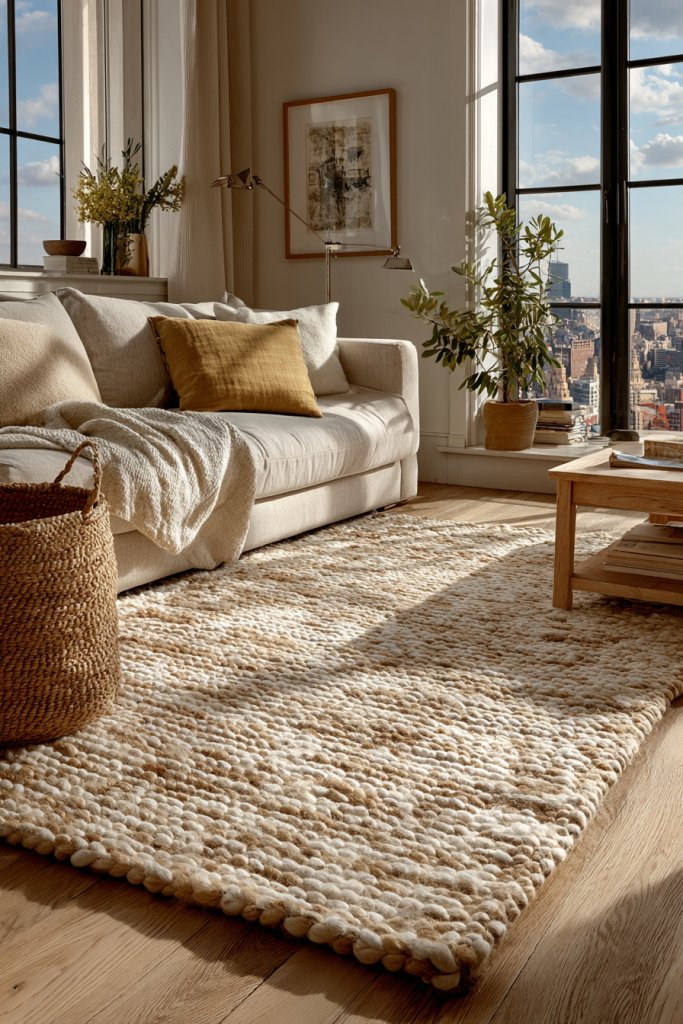
In a tiny living room, it’s easy for areas to blend together and become indistinct. You want to create zones for lounging, dining, or reading without adding bulky furniture or heavy colors. Light-colored rugs can define each space with subtlety and elegance. They add warmth and texture without overwhelming the room’s scale.
Imagine a soft cream or pale grey rug layered over a neutral hardwood floor. It delineates a cozy seating area with a sofa and a couple of accent chairs, all in similar light tones. The fibers feel plush underfoot, inviting you to relax. The light hue reflects daylight, making the area feel more expansive. Small decorative pillows and throws complement the rug, creating a cohesive and inviting look.
Choose rugs with subtle patterns or textures to add visual interest without cluttering your senses. Incorporate layered rugs of different sizes for a boho vibe or keep it simple with a single large rug. Seasonal updates include swapping out light, airy materials in summer for warmer textures in winter. For a minimalist style, stick to monochrome tones; for a more eclectic look, add colorful borders or intricate weaves.
Start by measuring your space and selecting a rug that fits comfortably without overwhelming the room. Anchor your furniture on or around the rug to create a grounded, cohesive look. Opt for materials like wool or synthetic fibers that are durable and easy to clean. Ensure the edges are finished properly to prevent fraying. Regularly vacuum and rotate to maintain appearance and longevity. Avoid overly busy patterns that distract from the overall sense of openness.
Use complementary textiles—cushions, throws, or curtains—in similar light tones. Add a decorative border or trim to the rug for a custom touch. Incorporate metallic or wooden accents nearby for contrast and warmth. Personalize with small decorative objects placed on the rug’s edges, or create a layered look with smaller accent mats.
Light-colored rugs are a simple way to visually expand and organize your small living space. They evoke calm and clarity, making your home a serene retreat. With minimal effort, you can redefine your room’s zones and improve overall ambiance. Ready to brighten and delineate?
10. Floating Wall-Mounted TV Units for Free Floor Space

Cluttering your living room with bulky TV stands can eat up valuable space, making the room feel cramped. You want a sleek, minimal look that keeps your entertainment area streamlined and open. Wall-mounted floating TV units are the perfect solution, freeing up floor space and creating a modern aesthetic. They provide a clean, clutter-free focal point that doesn’t dominate the room.
Picture a slim, wall-mounted console in a matte finish, with a flat-screen TV floating above it. The unit holds essential media devices and accessories, neatly tucked away behind closed compartments. The wall behind is painted in a neutral tone, with subtle LED lighting highlighting the setup. The space feels airy and organized, with nothing on the floor except maybe a small rug or pouf nearby. This setup maximizes visual openness while maintaining functionality.
Choose units with open shelving, closed cabinets, or a mix of both, depending on your storage needs. For a high-tech look, incorporate sleek, glossy panels; for a more organic feel, opt for natural wood finishes. Position the unit low to the floor for a grounded look or mount it higher for a floating effect that emphasizes height. Seasonal updates include changing the wall color or adding decorative wall decals nearby.
Secure the unit into wall studs for stability, using a level for precise placement. Measure the height carefully to ensure comfortable viewing angles. Conceal cables with in-wall wiring kits or cable management systems for a clean look. Attach the unit with appropriate brackets and test its stability. Keep the surrounding area clear of clutter, and add a small side table or seating for comfort. Regularly check for loose fittings or damage.
Add decorative elements on top, like a sculpture or a small plant (avoiding the restricted items). Use wall-mounted shelves or picture ledges nearby for personal touches. Incorporate ambient lighting—such as sconces or LED strips—to enhance the modern vibe. Change accessories seasonally to keep the look fresh and inviting.
Floating TV units keep your living room feeling spacious and uncluttered. They reflect a sleek, modern lifestyle and make your entertainment setup feel seamless. Once installed, you’ll enjoy a cleaner look and more open space to relax or entertain. Ready for a smarter, more stylish setup?
11. Compact Accent Chairs for Flexible Seating
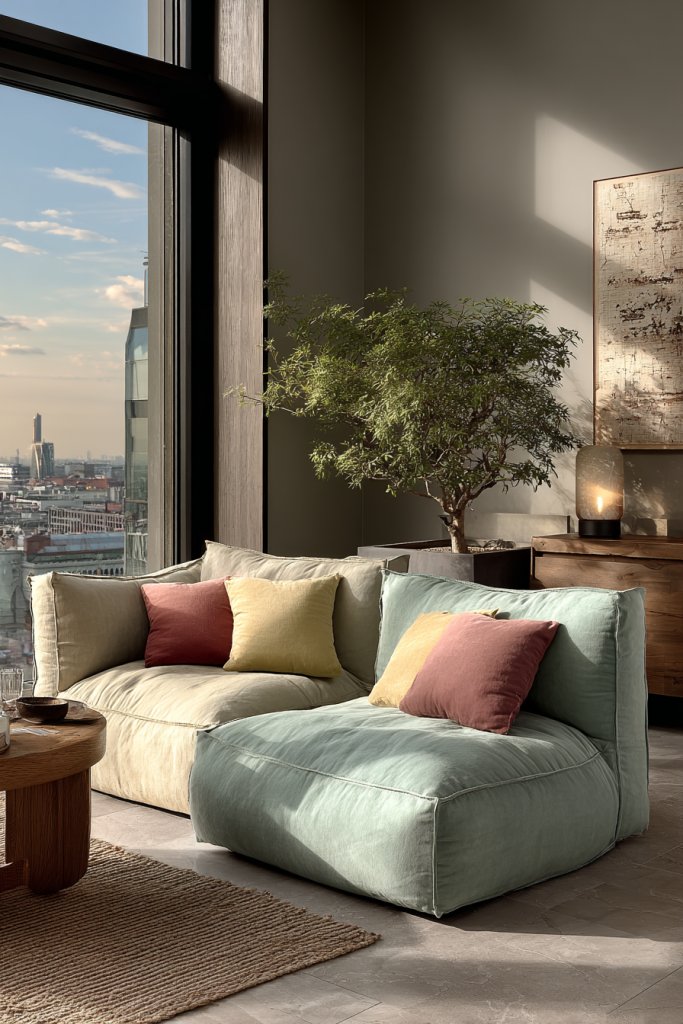
Small living rooms often lack enough seating for guests, but large armchairs can overwhelm the space. You need versatile, stylish chairs that can be moved around easily and don’t dominate the room. Compact accent chairs fit perfectly—adding a pop of color or texture without crowding. They’re the secret to flexible, functional seating that adapts to your needs.
Visualize a set of small, colorful chairs tucked into a corner or pulled up near a window. They feature sleek legs and lightweight frames, making them easy to move. The upholstery is a vibrant fabric that adds personality—think bold patterns or soft pastels. When you need extra seating, pull them out; when not, they tuck away neatly. The room retains its open feel, and each chair becomes a statement piece.
Choose chairs with removable covers for easy cleaning or seasonal updates. Mix and match different styles for an eclectic look, or keep to a uniform color palette for sophistication. Use lightweight materials like rattan, metal, or molded plastic for maximum portability. For outdoor living, select weather-resistant fabrics and frames. The flexibility allows you to adapt your seating for any occasion or season.
Pick chairs that are proportionate to your space—small enough to tuck away but comfortable enough for sitting. Place them near your main seating area or by a window for added coziness. Keep them lightweight so you can rearrange easily when hosting or cleaning. Use protective pads on the feet to prevent scratching floors. Store extra cushions or throws nearby for added comfort and style. Regularly dust or clean the upholstery to keep chairs looking fresh.
Add decorative cushions in patterns or textures that complement your decor. Personalize with slipcovers or fabric wraps in seasonal colors. Incorporate small side tables or ottomans nearby to serve as multifunctional accents. Personal touches like a throw blanket or a small sculpture can elevate their style and comfort.
Small accent chairs add versatility and personality to your living room. They’re perfect for creating cozy corners or extra seating without cluttering the space. With the right choice, they make your room more welcoming and functional. Ready to add some flair?
12. Hidden Niche Storage Behind Wall Panels
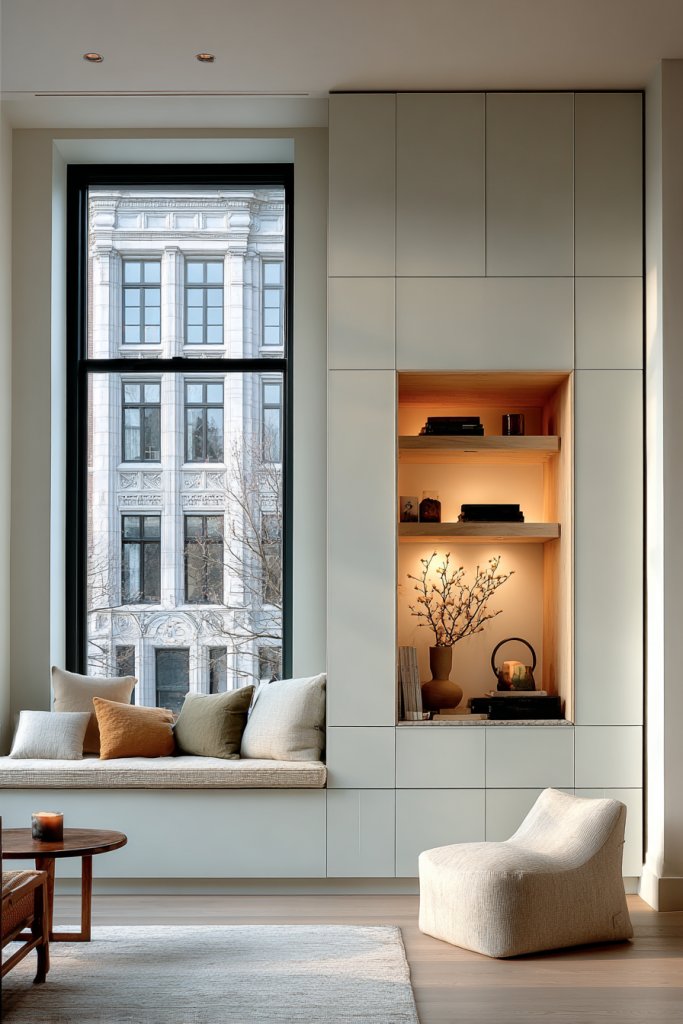
Clutter can quickly take over small spaces, making your living room feel chaotic and cramped. You need a discreet way to store essentials without sacrificing style. Hidden niche storage behind wall panels offers a sleek, seamless solution—concealing clutter while maintaining a polished look. It’s perfect for those who love clean lines and minimalism.
Imagine a wall with decorative panels that slide or lift away, revealing a hidden compartment filled with neatly organized items. The panels can be textured wood, painted in neutral tones, or feature subtle patterns. When closed, they blend perfectly with the rest of the wall, creating a smooth, uninterrupted surface. When open, they reveal a practical storage space that keeps your belongings out of sight yet easily accessible. It’s like having a secret storage vault in your home.
Opt for sliding panels, hinged doors, or magnetic covers depending on your aesthetic preference. Use different materials—wood, lacquer, or fabric-covered panels—to match your decor. Incorporate lighting inside the niche for easy access or visual interest. Seasonal decor updates can include changing panel colors or textures to refresh the look. The key is balancing function with design seamlessly.
Plan your wall layout, and identify a suitable spot—near your sofa or in a corner. Install sturdy framing and secure panels with heavy-duty hinges or sliding mechanisms. Keep the interior organized with baskets, dividers, or small containers. Ensure easy access by testing the mechanisms thoroughly. Maintain the panels by cleaning or repainting to keep them looking fresh. Consider hiring a professional for complex installations.
Decorate the panels with textured finishes, patterns, or even personalized engravings. Add LED strips or small lights inside for visibility. Use decorative handles or pulls that match your hardware. Incorporate your favorite colors or motifs for a custom touch. These hidden panels become a clever feature that adds personality and functionality.
Hidden niche storage elevates your interior design while solving storage issues discreetly. It keeps your space clean, organized, and visually appealing. Once installed, it’s like having a secret weapon for clutter control. Ready to hide away your mess?
13. Use of Dual-Purpose Decor Items
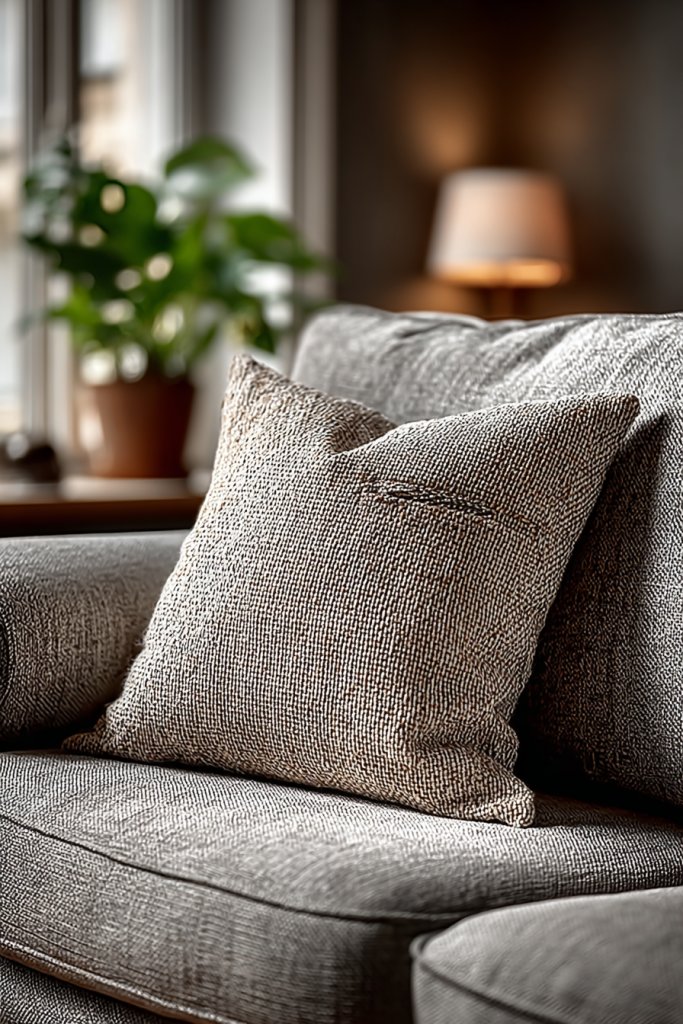
Decorating a small living room often feels like a balancing act—how to add personality without clutter? Dual-purpose decor items let you kill two birds with one stone, serving as both aesthetic accents and functional storage or utility. They help you create a stylish, clutter-free environment that doesn’t compromise on design.
Picture a woven basket that doubles as a side table or a decorative box that stores magazines and looks charming on your coffee table. Or a statement sculpture that also functions as a coat hook or a bookend. These items come in a variety of textures, from woven rattan to sleek ceramics, adding tactile interest. Their multifunctionality means fewer pieces cluttering your space, while still making a bold style statement.
Select items that fit your decor theme—rustic, modern, boho, or minimalist. Use decorative baskets for storing throws, pillows, or toys. Incorporate sculptural objects that also serve as light catches or conversation starters. Change out accessories seasonally to keep your space fresh. Combining different textures and finishes adds depth without overcrowding.
Identify areas where multifunctional decor will have the most impact—near seating, entryways, or corners. Choose pieces made from durable, easy-to-clean materials. Combine with other storage solutions to maximize efficiency. Place items thoughtfully, ensuring they don’t block pathways or views. Regularly reassess and swap out decor to maintain visual interest.
Add personal touches by customizing covers or finishes of multifunctional pieces. Use labels or tags on baskets to organize contents. Incorporate your favorite colors or patterns for a cohesive look. Mix decorative items with practical ones to create a home that’s both beautiful and functional.
Dual-purpose decor items are a clever way to keep your small space stylish and functional. They reduce clutter and highlight your personal taste. With a little creativity, your home can be both beautiful and efficient. Ready to upgrade your decor game?
14. Minimalist Window Treatments to Maximize Light
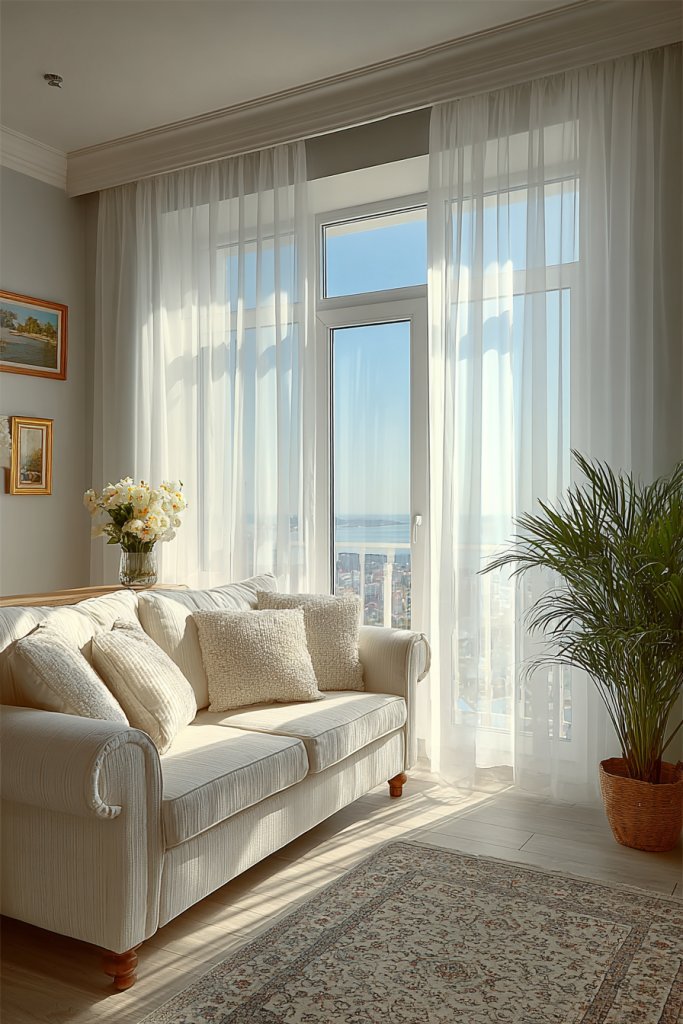
Heavy drapes and bulky blinds can block natural light, making a small living room feel dark and confined. You want to maximize sunlight to create a bright, airy atmosphere. Minimalist window treatments—like sheer shades or simple roller blinds—offer a sleek solution that enhances openness. It’s a small change that makes a big difference.
Imagine sheer, white roller shades that filter sunlight softly into the room, creating a gentle glow. Or lightweight linen curtains in neutral tones that add texture without adding weight or bulk. The light fabric dances with the breeze, bringing a sense of movement and freshness. The unobstructed view outside makes the room feel bigger, brighter, and more inviting. The minimalist treatment complements modern, Scandinavian, or coastal decor styles effortlessly.
Choose from roller shades, bamboo blinds, or simple pole curtains depending on your style. For a more dramatic effect, layer sheer curtains with blackout blinds for daytime versatility. Use light, breathable fabrics in warm seasons and heavier textures in winter for insulation. Keep hardware simple—thin rods, discreet brackets, or hidden tracks for a clean look. Seasonal updates can be as simple as swapping out fabric or color.
Measure your windows accurately and select treatments that fit comfortably within the frame. Mount brackets or tracks high above the window to create an illusion of height. Use minimal hardware to keep the look sleek and unobtrusive. Ensure the fabric or material allows ample light to pass through while providing privacy. Regularly clean or dust the treatments to maintain a fresh appearance. Avoid heavy curtains that add visual weight to the room.
Add subtle decorative touches like tassels or fabric trims for a personalized flair. Choose colors and textures that match your overall decor theme. Use decorative holdbacks or tiebacks that blend seamlessly. Incorporate subtle patterns or textures in the fabric to add visual interest without overwhelming the space.
Minimalist window treatments help your small living room feel more spacious and brighter. They emphasize clean lines and simplicity, making your space feel less cluttered. Once in place, they add a polished, modern touch that elevates your entire decor. Ready to let more light in?
15. Modular Furniture for Customizable Layouts
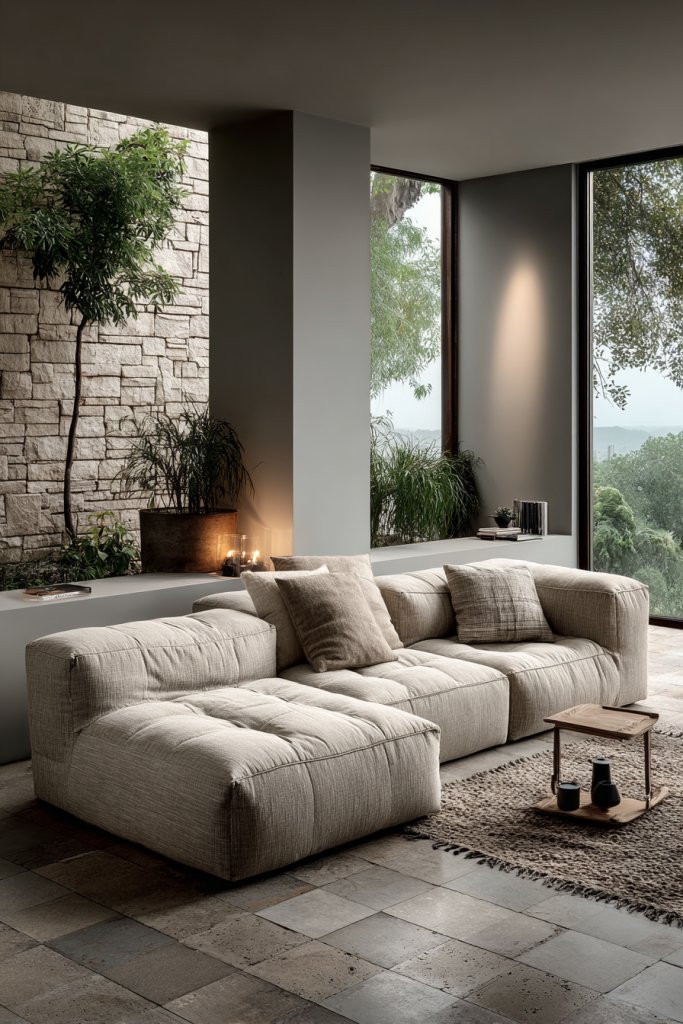
Fixed furniture can limit your options in a small space, making it hard to adapt to changing needs or moods. Modular furniture offers a flexible solution, allowing you to configure pieces into different layouts quickly. It’s like having a furniture puzzle that you can rearrange to fit your lifestyle. Flexibility and adaptability are the ultimate goals here.
Visualize a sectional sofa made of separate pieces that can be moved apart or pushed together. Or a set of stacked tables that serve as coffee tables, side tables, or even additional seating. The textures are neutral—think soft fabrics and sleek metal legs—that blend into any decor style. When rearranged, the furniture creates different zones—cozy corner, open lounge, or space for entertaining—all with a few simple moves. The visual impact is both practical and stylish.
Choose modular systems with different configurations—L-shape, U-shape, or separate seating. Mix and match different finishes or fabrics for eclectic or coordinated looks. For outdoor spaces, select weather-resistant options that can be rearranged seasonally. Use lightweight pieces for easy handling, especially in multi-use rooms. Seasonal updates include changing cushion covers or adding decorative throws.
Start by assessing your space and identifying your main needs—seating, lounging, or entertaining. Select modular pieces that can be easily moved and reconfigured. Secure or connect sections if needed to maintain stability. Incorporate compatible accessories like side tables or storage ottomans. Test different arrangements to find the most functional setup. Regularly reassess your layout to keep the space fresh and practical.
Personalize with colorful cushions, throws, or slipcovers that match your decor theme. Use decorative accents like a statement rug or wall art to anchor different configurations. Incorporate functional elements like built-in charging stations or hidden storage. Update the look with seasonal accessories—bright cushions in summer, cozy throws in winter—to keep things lively.
Modular furniture empowers you to adapt your living space easily, making it more versatile and fun. It’s perfect for small rooms that need to serve multiple purposes. With the ability to reconfigure, you can keep your decor fresh and suited to your current lifestyle. Ready to customize your space?
16. Compact Bookshelves for Personal Touches
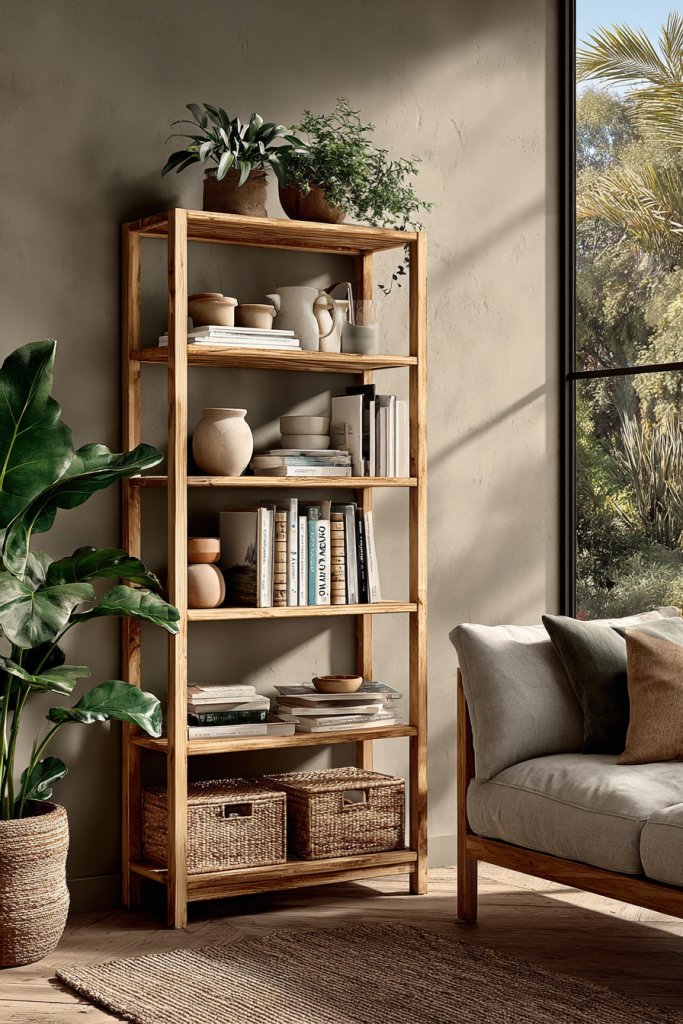
Small living rooms often lack space for personal mementos, books, or decorative objects. Overstuffed or bulky shelves can make the room feel crowded. The solution? Compact, vertical bookshelves that maximize storage while taking up minimal space. They add personality and character without overwhelming your decor.
Picture a slim, tall bookshelf tucked beside a sofa or in a corner, filled with a curated mix of books, framed photos, and decorative objects. The narrow profile and vertical orientation keep the room feeling open. The shelves are in a light or neutral finish, blending seamlessly with the wall. Small, colorful accents or art objects on the shelves add visual interest, making the space feel curated and personal.
Choose from open-back or closed-back designs based on your preference for display or concealment. Use adjustable shelves to accommodate various item sizes. Incorporate decorative storage boxes or baskets for a tidy look. For a playful vibe, mix in some quirky or vintage items. Seasonal styling includes swapping out books or objects to suit holidays or moods.
Measure your available wall space and select a bookshelf that fits proportionally. Secure it to the wall for safety, especially if you have pets or kids. Organize your belongings thoughtfully, grouping similar items together. Consider layering books with decorative objects for a curated look. Keep the shelves dust-free and rearrange periodically to keep the display fresh. Use labels or tags for extra organization.
Decorate with framed photos, small sculptures, or souvenirs that tell your story. Paint or stain the shelves to match your decor palette. Add fairy lights or LED strips for ambiance. Incorporate decorative bookends or unique hardware to elevate the style. These personal touches make the bookshelf a true reflection of your personality.
A well-styled bookshelf adds warmth and personality to your small living room. It’s a functional art piece that showcases your interests and memories. With the right placement, it makes the space feel more lived-in and inviting. Ready to show off your personal collection?
17. Layered Lighting to Create Depth and Warmth
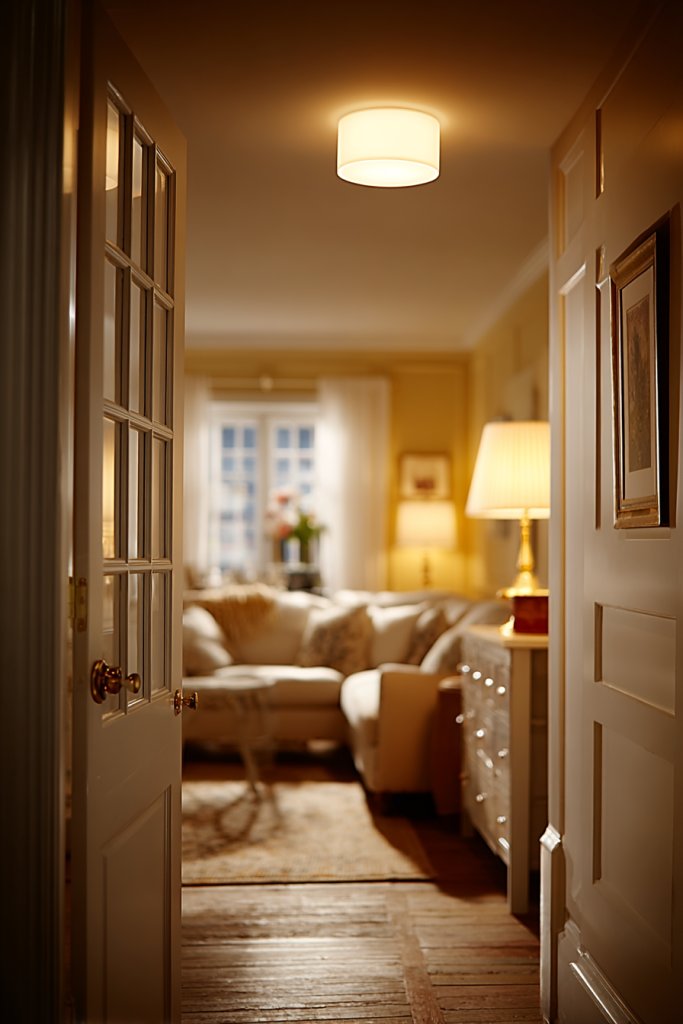
A small room can easily feel flat or dull without proper lighting. Relying on a single overhead light often isn’t enough to create a cozy, inviting atmosphere. Layered lighting adds depth, warmth, and functionality, making your space feel more dynamic. It’s the secret ingredient to transforming a plain room into a warm, welcoming haven.
Envision a combination of wall sconces illuminating artwork or architectural features, table lamps casting soft pools of light on side tables, and ceiling fixtures providing general brightness. The different layers create a nuanced ambiance that’s perfect for relaxing or entertaining. Use warm-toned bulbs to add a cozy glow, and dimmers to control the mood. The interplay of shadows and highlights adds visual interest and a sense of depth.
Choose fixtures that match your decor style—industrial pendants, sleek modern sconces, or vintage-inspired lamps. Incorporate smart lighting options or remote-controlled fixtures for convenience. Use different light intensities or color temperatures depending on the time of day or activity. For seasonal variation, swap bulbs or shades to match the mood—cooler tones for daytime, warmer for evening.
Plan your lighting layout by identifying focal points and areas needing task lighting. Install fixtures at appropriate heights—sconces at eye level, overhead lights at a height that evenly distributes light. Use multiple sources to avoid harsh shadows and dark corners. Make sure switches are accessible, and consider smart controls for easy adjustment. Regularly dust fixtures and replace bulbs to keep the ambiance consistent.
Personalize with decorative fixtures that reflect your style—vintage, minimalist, or eclectic. Use decorative lampshades, unique bulb shapes, or colored filters for added flair. Incorporate candles or LED candles for cozy evenings. Layered lighting isn’t just functional—it’s a key design element that sets the tone for your entire living space.
Thoughtful lighting turns your small living room into a versatile space full of ambiance and charm. It enhances features, adds warmth, and makes everything feel more intentional. Once mastered, layered lighting becomes your best tool for creating mood and highlighting your decor. Ready to light up your life?
18. Use of Open-Frame Furniture for Airy Aesthetic

Heavy, bulky furniture can dominate a small living room, making it feel cramped and oppressive. You need a design approach that maintains openness and airiness. Open-frame furniture—like coffee tables, side tables, and shelving—lets you see through the pieces, creating a sense of space. It’s a simple trick to make your room feel larger and less cluttered.
Imagine a coffee table with a thin metal frame and a glass top, allowing light to pass through and revealing the floor beneath. Or open shelving with clean lines that showcase your favorite books or decor without blocking sightlines. The furniture’s minimal structure emphasizes openness, while the airy design adds a modern touch. The overall effect is a space that feels light, fresh, and inviting.
Select furniture with slim profiles, lightweight materials, and open structures—think wire, acrylic, or distressed wood. Use these pieces to create visual pathways and avoid blocking views or light. For a cozy vibe, layer with textured textiles and soft cushions. For a more industrial or modern look, combine metal and glass with sleek finishes. Seasonal updates include swapping out accessories or adding colorful textiles.
Choose open-frame furniture that suits your space and style—measure carefully to avoid overcrowding. Assemble or place pieces where they enhance flow and light. Use transparent or reflective surfaces to amplify light and openness. Keep the furniture clean and free of excess clutter for a streamlined appearance. Regularly reassess your layout as your needs evolve, ensuring the space remains airy.
Add personal touches with textured cushions or throws that soften the look. Incorporate decorative objects like sculptural pieces or art that complement the open design. Use rugs or lighting to define zones without heavy furniture. Personalize with your favorite colors or finishes to match your decor theme.
Open-frame furniture creates a sleek, modern aesthetic that maximizes your room’s potential. It makes even the smallest spaces feel larger and more inviting. With thoughtful selection and placement, your living room becomes a stylish sanctuary that breathes. Ready to embrace the airy aesthetic?
19. Strategic Zone Planning with Area Rugs and Furniture Placement
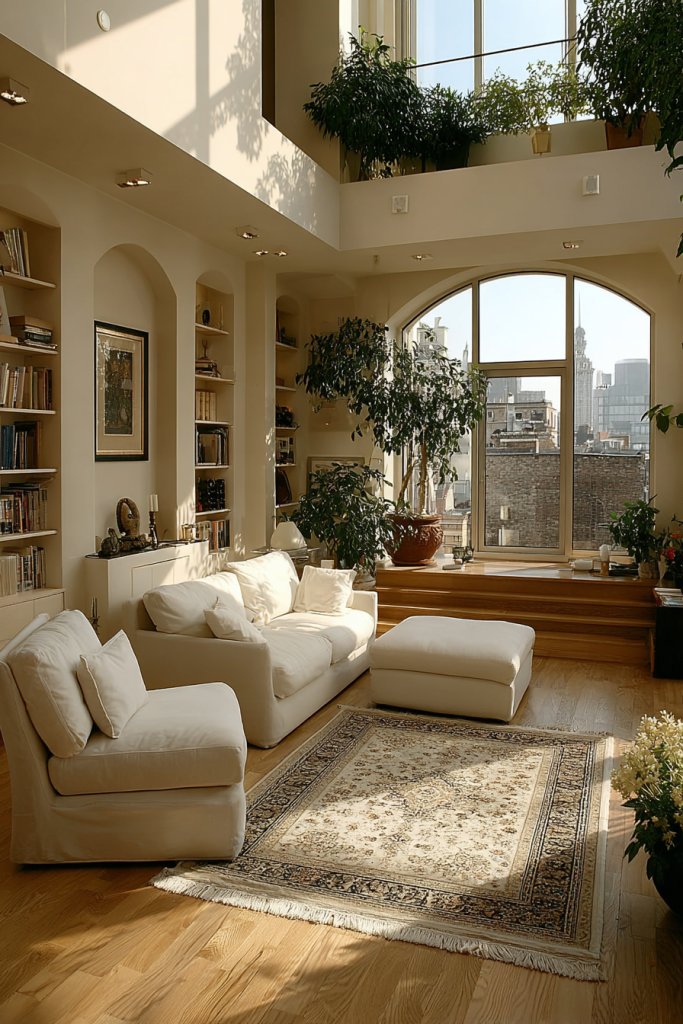
In a small living room, it’s easy for the space to feel disorganized and random. You want a way to create distinct zones—like a cozy reading nook or a conversation area—without adding walls or bulky partitions. Strategic furniture placement combined with small area rugs can define these zones clearly and beautifully. It’s a smart trick to optimize usability while maintaining an open feel.
Imagine a small rug in front of a sofa, anchoring a conversation zone, while a second, slightly smaller rug creates a cozy reading corner with a comfy chair and a side table. Carefully positioned furniture, like a slim console or a floating shelf, delineates each area without crowding. The rugs introduce color, pattern, or texture that enhances the overall decor. The arrangement invites easy movement and visual flow, making your space feel intentional and well-designed.
Use different-sized rugs to define multiple zones or unify the space with a single large rug. Choose colors and patterns that complement your overall decor, adding visual interest. For seasonal updates, swap out rugs or change furniture placements to reflect your current mood. Keep pathways clear and furniture proportions balanced for maximum comfort. This approach works equally well in open-plan layouts or studio apartments.
Start by measuring your room and selecting rugs that fit each zone proportionally. Arrange furniture to create natural traffic pathways and focal points. Anchor each zone with a rug that matches its purpose—cozy, casual, or formal. Use small tables, ottomans, or benches to enhance functionality within each zone. Regularly reassess and adjust furniture placement to optimize flow and comfort.
Coordinate rug colors with your decor for a cohesive look. Incorporate decorative cushions, throws, or artwork to enhance each zone. Use lighting—floor lamps, sconces, or fairy lights—to highlight specific areas and add ambiance. Personal touches like family photos or travel souvenirs can be placed nearby to make each zone uniquely yours.
Thoughtful zone planning makes your small living room more versatile and inviting. It creates a sense of order and purpose, making the space more functional and stylish. Once you master this, organizing your home becomes effortless. Ready to define your space?
Conclusion
With a mix of innovative furniture arrangements, smart storage, and thoughtful decor, these small living room ideas provide ample inspiration to revamp your space. Don’t be afraid to experiment and personalize each concept to suit your style and needs. Embrace the challenge of small space living and turn your living room into a functional, beautiful retreat that truly reflects you!